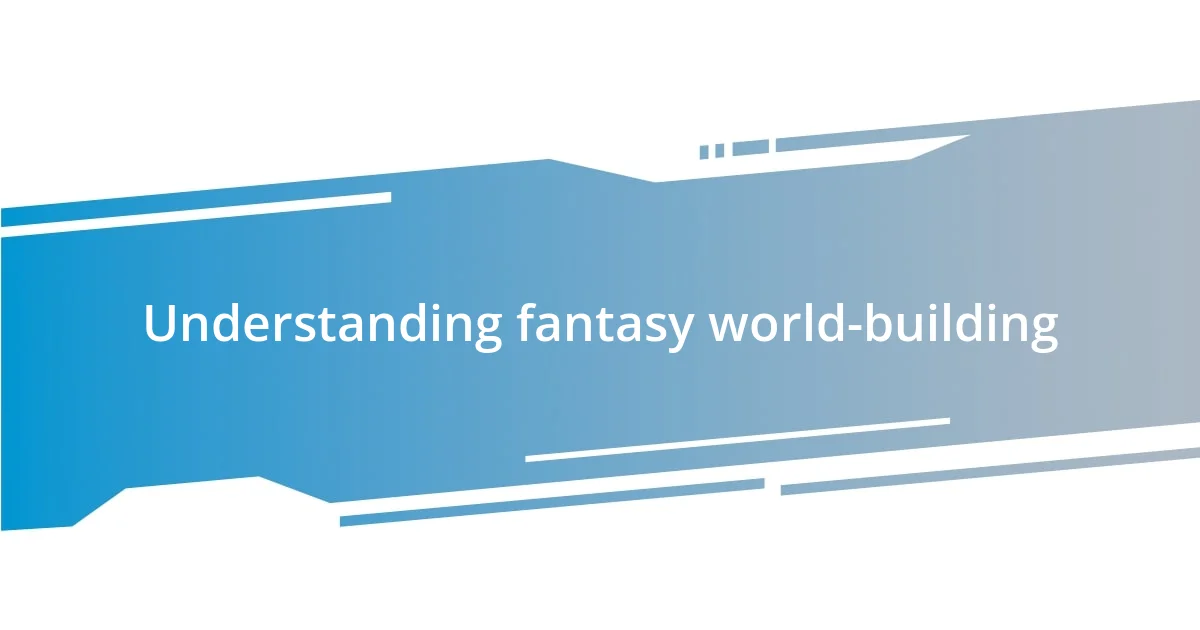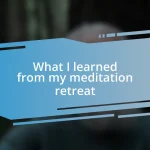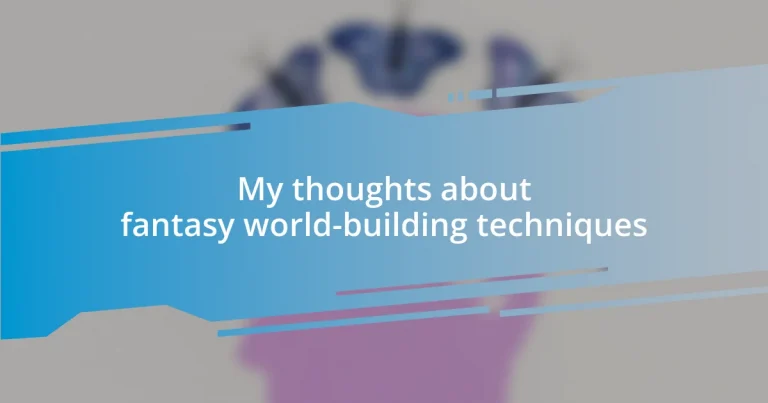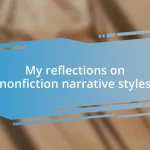Key takeaways:
- Effective world-building involves creating interconnected elements like geography, history, culture, and magic systems that enrich the narrative.
- Developing authentic cultures through traditions, intercultural interactions, and unique languages enhances reader engagement and reflects human experiences.
- Testing and refining your world, including character perspectives and resolving inconsistencies, leads to a more immersive and compelling fantasy setting.

Understanding fantasy world-building
Understanding fantasy world-building goes beyond just inventing a new realm; it’s about creating a living, breathing ecosystem. I remember my early attempts at craft a world where the geography influenced the politics and culture significantly. Have you ever considered how the terrain shapes the lives of its inhabitants? It’s a detail that can take your storytelling to a whole new level.
Another aspect that fascinates me is the intricate weaving of history and lore within a fantasy world. I found that developing backstories, even for minor characters, instantly enriched my narrative. When readers sense the depth behind a place or a person, it sparks curiosity and investment—don’t you think a rich history makes the world feel more authentic?
Ultimately, it’s about how you engage your audience’s imagination. I’ve experienced firsthand how carefully thought-out details, like language or traditions, can transport readers into the heart of a world. When they can visualize not just the sights, but the sounds and flavors of your creation, it becomes a vivid experience that resonates long after they put the book down. Who wouldn’t want to dive into such an immersive escape?

Key elements of world-building
The key elements of world-building are crucial to crafting a believable and immersive experience. I recall a time when I decided to create a vibrant marketplace in my fantasy realm. It wasn’t just about the stalls or the vendors; I had to think about the smells of roasted meats and fresh fruits, the sounds of haggling, and the sights of colorful fabrics waving in the breeze. These sensory details helped to breathe life into my setting, making it feel real.
Here are some key elements I focus on when building a world:
- Geography: How does the landscape shape cultures?
- History: What past events shaped the present?
- Cultures: What are the customs, traditions, and beliefs of its inhabitants?
- Languages: Are there distinct languages or dialects that reflect cultural nuances?
- Economics: What drives trade and wealth in the society?
- Magic systems: What rules govern magic, if it exists?
- Flora and fauna: How do the local plants and animals influence daily life?
Each of these elements contributes to an intricate tapestry that enhances the reader’s experience, encouraging them to fully engage with the narrative. I remember feeling a sense of achievement when I introduced a unique creature in my story; it added layers of intrigue and wonder that made my readers excited to explore further. These pieces don’t just fill the world; they enrich it, connecting readers to the story on a deeper level.

Techniques for creating cultures
Creating cultures within a fantasy world is a craft that demands attention to detail and a genuine understanding of human experiences. From my own journey, I’ve realized that cultures can be built through shared practices, rituals, and everyday lives. I vividly recall designing a festival for my characters, where they would celebrate the changing seasons with songs, dances, and feasts. This celebration felt authentic because it mirrored the traditions I grew up with, bringing a personal touch that resonated deeply with my readers. Isn’t it fascinating how shared moments can bridge the gap between fantasy and reality?
Another effective technique is to explore how different cultures interact with each other. I once crafted a storyline where neighboring tribes engaged in trade and diplomacy, each bringing unique perspectives and customs to the table. Through misunderstandings and alliances, I found a rich vein of conflict and resolution that not only drove the plot but also allowed readers to reflect on the beauty of diversity. When cultures clash or collaborate, it can reveal deeper truths about humanity that often resonate with our own lives.
Finally, creating languages or dialects can add an impressive layer to cultural identity in your world. I tried my hand at developing a few phrases and idioms that were unique to my characters. The challenge was balancing accessibility with authenticity. I remember when a particular phrase I invented ended up being a favorite among my readers, sparking discussions online. This experience showed me the profound connection that language can foster within a cultural setting, inviting readers to immerse themselves even further.
| Technique | Description |
|---|---|
| Celebration of Traditions | Creating festivals and rituals that reflect shared practices enriches cultural depth. |
| Intercultural Interaction | Exploring trade, diplomacy, and conflicts between cultures adds complexity and realism. |
| Language Development | Inventing unique phrases or dialects enhances authenticity and fosters deeper connections. |

Developing unique magic systems
When creating a unique magic system, I always begin by establishing clear rules. This foundation prevents magic from feeling like a convenient plot device. For example, in one of my stories, I designed a system where each spell drained the user’s health—effectively turning magic into a precious resource. This limitation not only added tension but also sparked complex character decisions. I wondered how my characters would weigh their ambition against their well-being, and it made for some gripping storytelling.
I’ve also learned to tie the magic system to the world itself. This connection enriches the setting and informs the culture. Imagine a realm where magic flows from the land, influenced by its geography—mountains might enhance defensive spells, while forests boost healing abilities. When I crafted a storyline around this concept, it felt natural for my characters to respect the land because their survival depended on it. I realized that grounding magic in the physical world not only lay the groundwork for rich lore but also fostered a deeper respect for nature.
Another aspect I explore is the societal impact of magic. I’ve noticed that when magic becomes commonplace, the social dynamics shift considerably. For instance, in one of my narratives, the emergence of a certain type of magic created a class system, with the elite hoarding powerful spells. This tension birthed themes of inequality and rebellion, allowing me to examine how power dynamics can influence relationships and communities. Isn’t it intriguing to think about how a unique magic system can reflect our own societal issues? That’s the kind of depth I strive to achieve when building my fantasy worlds.

Creating geography and settings
Creating geography and settings is like laying the foundation for a house; it shapes everything that comes after. When I built a world inspired by my travels through the Scottish Highlands, it wasn’t just about beautiful landscapes. I discovered that the geography influenced how cultures developed, how people interacted, and what conflicts arose. I remember vividly sketching out a rugged mountain range where factions would compete for access to vital resources. The steep cliffs weren’t just aesthetic; they became a strategic barrier, creating a natural rivalry that added depth to my stories.
One technique I’ve found effective is using climate and terrain to dictate the lifestyles of my characters. For instance, in a dry desert realm I conceptualized, the scarcity of water shaped social structures and rituals. The moment I decided that the inhabitants worshipped rain like a deity, it changed everything. It added layers to their culture and made their struggles feel tangible. Could you imagine the sheer desperation and joy of those characters when rain finally arrived? That emotional turmoil resonated with me, and I wanted it to resonate with my readers, too.
I often think about how geography can serve as a character in its own right. In one story, a sprawling forest was not just backdrop; it was alive with its own ecosystem and secrets. I vividly recall writing scenes where my characters got lost, not just physically but also emotionally, reflecting their personal struggles. The forest became a symbol of their journey—a place of both danger and refuge. Isn’t it exciting to think about how the very land can reflect the internal and external conflicts of your characters? That’s the magic of intertwining geography with storytelling.

Building compelling character arcs
When I focus on building compelling character arcs, I start by defining what drives each character. I believe that their motivations should align with their experiences and growth throughout the story. For instance, in one narrative I penned, a warrior grappling with guilt after a significant loss transformed into a protector for those he once fought against. It was fascinating to explore how his inner turmoil shaped his decisions; the conflict between revenge and redemption created a layered emotional journey.
Character arcs also flourish when there are clear stakes at play. I often think of a character I wrote who desperately sought approval from her estranged father. This need led her to make choices that conflicted with her values, leading to a climactic moment of truth where she had to decide between loyalty to family and staying true to herself. This internal battle not only made her arc compelling but also resonated emotionally with readers who might have faced similar dilemmas.
Additionally, I find that allowing characters to make mistakes—real, relatable ones—can drive their arcs forward in a meaningful way. I remember crafting a story where a young mage misused her powers, causing unintended consequences that spiraled out of control. Watching her navigate the aftermath, confront her flaws, and ultimately seek to rectify her errors felt profoundly satisfying. It prompted me to ask: Don’t we all learn and grow through our missteps? Incorporating this element has proven to create characters that readers want to root for, reflecting the real challenges we face in our own lives.

Testing and refining your world
Testing your fantasy world is a journey that should feel as invigorating as it is revealing. When I began to flesh out a new kingdom, I didn’t just rely on my notes; I put my ideas to the test through tabletop role-playing games with friends. Watching their reactions to my world-building decisions was enlightening. Their questions and unexpected choices highlighted areas I hadn’t considered, nudging me to refine and expand the lore, which ultimately made the world feel more alive.
Refinement often comes from stepping back and evaluating the inconsistencies in your world. During one writing spree, I realized that my magical system contradicted itself. Instead of ignoring it, I sat down to identify the core rules. I asked myself: What would happen to the characters if these rules were broken? That exercise not only solidified my magic system but also inspired plot twists that added tension and depth. Isn’t it interesting how challenges can lead to creative breakthroughs?
I also advocate for experimenting with perspectives—your characters don’t experience your world the same way you do. When I wrote from the viewpoint of a creature fundamentally impacted by the land’s curse, it forced me to rethink the social structure I had created. The depth of emotion and unique insights that emerged surprised even me. It made me wonder: How many other perspectives have I overlooked that could enrich my story? Embracing these tests and adjustments can transform a basic setting into an immersive and compelling world that resonates with readers.














